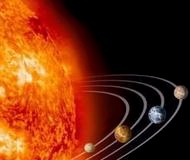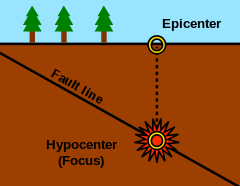
|
|||
| Contents | Prev | Next | |
![]()
14. What Causes Earthquakes?
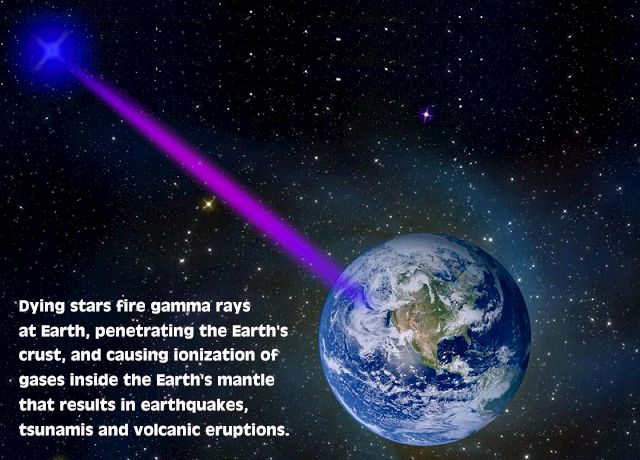
Earthquakes currently attributed to earth plates moving and clashing with each other.
The movement of earth plates is a result, and not a cause.
The factor that caused the earth's mantle to explode in the first time, that led to the Great Dying 200 million years ago, must be the same factor that causes these disasters on Earth nowadays. That factor is the energy that causes chemical reactions and expansion in the mantle's substances.
In the past, that energy was gamma rays fired by the second sun. Nowadays it is fired by distant dying stars, specifically pulsing stars (pulsars).
What makes the pulsar energy to go undetected is that the effect of this energy takes time to show up. Chemical reactions do not occur instantly.
A question may arise, if earthquakes are caused by cosmic rays from space,
and these rays can hit Earth anywhere, then why earthquakes happen in certain
areas only and not everywhere? The most likely reason is that the basalt layer
is very thin in the areas where earthquakes occur very frequently, so when dying
stars fire gamma rays at these areas, where the basalt layer is very thin, they
penetrate to the earth's mantle, and cause earthquakes in these weak areas, but
when they fire gamma rays at areas where the basalt layer is thick, the rays get
blocked by the thick layers and prevented from reaching the mantle.
Can Animals Sense Earthquakes?
Some animals sense earthquakes before they happen:
"In 373 B.C., historians recorded that animals,
including rats, snakes and weasels, deserted the Greek city of Helice in droves
just days before a quake devastated the place. Accounts of similar animal
anticipation of earthquakes have surfaced across the centuries since."
nationalgeographic.com

eqsigns.net
Even though the animals in the video clips reacted strangely to magnetic pulses, magnetism is unlikely the energy they sense to predict earthquakes.
The video clips show only a small group of animals. If a large group of different animals and birds are tested against magnetic pulses, will all of them show strange behavior?
The page on the link below and many other pages say all kinds of animals, birds, reptiles, and even insects can sense earthquakes!
"Animals, birds and earthquake predictions"
kiwitravelwriter.wordpress.com

egu.eu/news/
Smell is the only communication language of insects and reptiles.
Some birds, like homing pigeons, and animals, like cats and dogs, are also found having very strong sense of smell. But who knows, maybe all creatures, other than humans, can communicate, or identify things, via the sense of smell.

"Ants may have the ability to sense
earthquakes before they hit according to observations presented at the
European Geosciences Union annual meeting."
wired.co.uk/news/
The antenna on the top of ant's head is the sense organ of the ants. They use it to identify danger and finding food, and also to communicate with each other.
What we see here is that the sense of smell is the common factor among all creatures that can predict upcoming earthquakes.
When ionization of gases occurs inside the mantle, new gases are produced. One or more of these new gases, or gas mixtures, could be acting as a warning signal for animals, birds, and insects, and force them to leave their homes to places where the signal completely disappears.
Some people have tried to use the animal behavior as a precursor of earthquakes. But the animal behavior turned out a hit or miss! This is possible if the actual chemical reaction inside the mantle, and also the earthquake, is happening in a far place, tens of kilometers away from the city, in the sea for example, but its effect reaches the city and causes a disaster there.
Changes in Atmosphere
For centuries people have observed changes in the atmosphere prior to major earthquakes. Recent studies showed that the changes can reach up to the ionosphere, a layer in the atmosphere that starts at 80 km above the earth surface.
"These observations include: thermal infrared radiation;
radon/ion activities; air temperature and humidity, and concentration of
electrons in the ionosphere."
ntrs.nasa.gov
These atmospheric changes (that must be caused by gases interacting with air) are basically the same signs that signal animals to leave their places. But humans are not as good as animals in understanding the signs; so they correlate the signs with earthquakes only after earthquakes actually strike.
"Japan Earthquake Was 'In the Air' Days Before,
Scientist Claims"
livescience.com
The concentration of these atmospheric changes are found mainly above epicenters; areas where the basalt layer under the earth's crust is greatly damaged. This indicates that the gases that cause atmospheric changes (humidity, temperature, smell, etc.) are coming from the earth's mantle. So what can force gases to leave the mantle other than an increase in gas volume or pressure? And why do these gases get their volume increase in the first place? The most likely factor to cause this thing to happen is an ionization process taking place inside the earth's mantle. And if gas ionization is the case, there must be an ionizing energy inside the mantle.
Tsunamis and Earthquake Islands

Tsunami is a rise of sea water level. It is attributed to earthquakes happening under the sea that causes an uplift of a section of ocean floor.
Another possibility is ionized gases that are being released along major fault lines in the sea. These gases interact with sea water and create high and long water waves.
Of course, the sudden release of gases can also create an earthquake. But the earthquake itself is not the cause of tsunamis.
Some other earthquakes cause islands to form. Below are two examples.
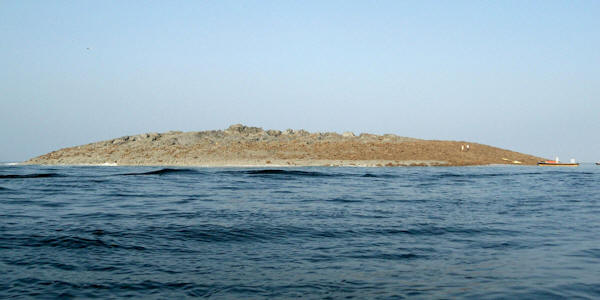
ibtimes.co.uk
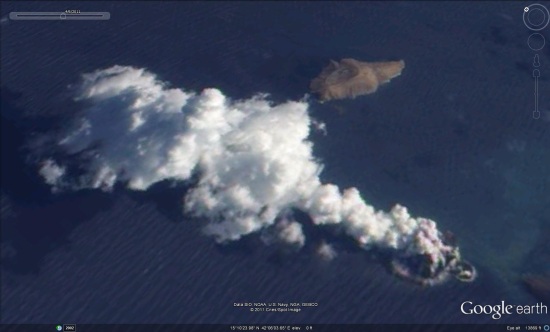
What can cause a piece of land to go up, other than a push, pressure, from bottom?
If there is something being lifted up, there must be something else lifting it from bottom. Based on this simple logic, there is nothing we can see that can raise these islands, other than the gases that are also coming out of the nearby volcano, in the picture above.
Regarding the Pakistan earthquake, that island was also an ancient volcano!
In both cases, in Pakistan and the Red Sea, we find the gas as the common
factor.
Earthquake Lights
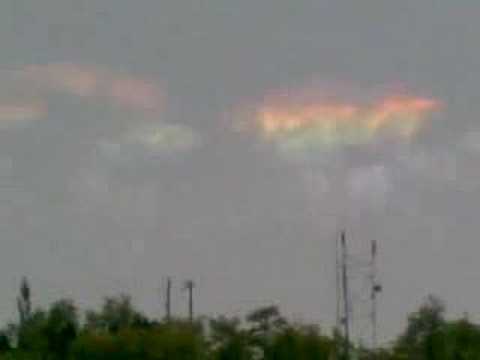
youtube.com
The picture to the right is of a China earthquake. The sky has changed color in a far distant place. After 30 minutes, a quake struck in a different area.
Based on what is seen in this picture, these strange clouds seem to be rising from the ground.
It seems that ionized gases from the mantle interacted with air particles in the sky and formed new substances that look in color like rainbow. It is possible that the ionized gas particles in the mantle continued to move forward until it reached a major fault line and caused a disaster there, or the earthquake could have been caused by another and bigger ionization process took place in the area where the earthquake struck.
These strange clouds are called Earthquake Lights. It is mentioned on the
link below that the so-called earthquake lights: "have been accompanied by
low-frequency radio noise in the
10 to 20 kHz
range. Earthquake lights have been seen weeks before or after earthquakes and
hundreds of kilometers from the epicenter."
geology.about.com
youtube.com
In addition to the dangerous energies pulsars emit, they also generate frequencies in the range of human hearing, roughly between 20 Hz - 20 kHz. This frequency range is almost the same as the range of frequencies mentioned in the quote above.
If this range of frequencies is converted to sound, it can be heard. The video on YouTube on the link under the picture to the right is an example of this conversion.
It might be possible that the pulsar sound, if studied properly, in correlation with other energies the pulsar emits, to be used as an early warning signal for earthquakes and other natural disasters!
It doesn't seem there is any recording of the earthquake frequency mentioned in the quote above published on the web, but even if a recording of this frequency does exist, it is unlikely to be as clear as the sound recording found on YouTube, because the recording must have been done on Earth, and that frequency range cannot penetrate the Earth atmosphere without severe distortion. However, if it is possible to filter out distortions and noise from the recording, a tone very close to the one found on YouTube might be recovered.
It is also mentioned in the quote above that these clouds have been seen
sometimes "before" and sometimes "after" earthquakes, and hundreds of kilometers
away from the epicenter -- Now we do not have a clear picture of what is
happening inside the earth's mantle, so we don't know whether these same ionized
gases have created clouds in one area and then continued to move to a different
area where they created an earthquake, or they are separate strikes of gamma
rays on different areas; in one area they have been attenuated too much by the
basalt layer, so they created a little ionization in the mantle gases that
resulted in earthquake clouds, whereas they have not been attenuated that much
in the other area where they have caused an earthquake. But regardless which
assumption is correct, or maybe both, the point is that an ionization process is
happening inside the earth's mantle and resulting in strange clouds and
earthquakes.
Volcanic and Earthquake Lightning
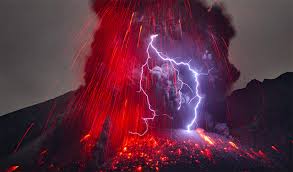
Volcanic Lightning is very similar to rain lightning. Both are created when an electrically charged region discharges suddenly into a negative region of air or the ground.
There is also a phenomenon called, Earthquake Lightning. This is different from the Earthquake Lights mentioned earlier:
"In some parts of the world, earthquakes are often accompanied by ball lightning, stroke lightning and sheet lightning." (nature.com)
The presence of charged, positively ionized, particles in volcanic gases and
earthquakes shows that an ionization process is taking place inside the earth's
mantle, before, during, and after, the time of earthquakes and volcanic
eruptions.
Earthquakes and Magnetic Field Fluctuations
Earthquake researchers in Japan and Taiwan have observed fluctuations in
magnetic field on the surface of the earth, prior to, and at the time of, major
earthquakes.
terrapub.co.jp
As mentioned in another section, moving ionized gases create a magnetic field.
QUOTE: "Motion of an ionized gas will
produce a magnetic field."
stars.astro.illinois.edu
The magnetic field created by the positively charged gases inside the mantle must be very, very strong, in order to cross the land crust and cause magnetic fluctuations on the surface of the earth.
In a similar phenomenon, "rain" lightning creates a magnetic force of a very
great magnitude. Sometimes it causes fluctuations in electricity and introduces
noise in electronic communications and radio channels. So there is no difference
between rain lightning and earthquake/volcanic lightning, or the magnetic field
introduced by both.
Forecasting Earthquakes and Related Natural Disasters
We have seen in the previous paragraphs some signs and examples of earthquakes and the like. Every single sign and phenomenon must be taken into consideration before making any conclusion. The common factor for all the signs that have been presented in this section is the gas.

But where to watch for the ionization of gases? In the sky? Of course not. Not all animals are in the sky, but all of them sense earthquakes before they happen. The one and only one place that is known for releasing gases is the earth's mantle. Fortunately, we do not have to dig to the mantle in order to identify the gases available there. The mantle is releasing these gases via cracks (fault lines), and volcanic craters.
One way to test for the gas that acts as a warning message to animals is to take samples of volcanic gases and ionize them inside a laboratory with gamma ray, in the presence of animals, birds, reptiles, and insects. Gas sensors for all kinds of gases, and gas level indicators, have to be installed. Nerve instruments have to be mounted on the bodies of the animals under test. Experiments and good analysis of results should lead to the identification of the gas that acts as an earthquake sign.
Experimenting with ionization of volcanic gases and direct gamma or neutron ray strikes with air and very thin water vapor in order to produce earthquake lights, the lights that look like rainbow. Although this is a very difficult experiment to make, it is very important, because it gives a visual result.
Even though magnetism is not the cause of earthquakes, and changes in the magnetic field will not make colors of clouds in the sky to look like rainbow, but it can be used as a sign. Moving ionized particles generate a magnetic field. The presence and direction of magnetic pulses should be detectable by sensitive magnetic sensors. The data from these sensors will let people watching for earthquakes to know where the ionized gases are heading, at what speed, and on which major fault line they will strike. Magnetic sensors are to be used with gas sensors to avoid false indications.
Frequency meters for measuring and monitoring the range of frequencies from 10 Hz to 20 kHz are also required. The antennas of these meters/recorders should be mounted above mountains, in places where the noise level is very low. The result must be studied in correlation and comparison with pulsar frequencies.
The above ideas may not be sufficient for forecasting earthquakes accurately. But if they are taken as basis, and tested properly, and the results are analyzed correctly, they should lead to new ideas, ways, and procedures, which will result in accurate forecasting of earthquakes and other natural disasters.
![]()
| The full report in a single page | ||
| Contents | Prev | Next |
